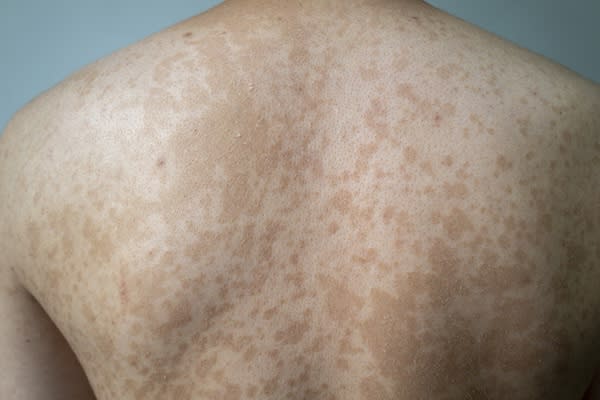Tinea versicolor: Causes, symptoms and treatment

[8 MIN READ]
In this article:
-
Tinea versicolor is a common fungal infection of the skin. It causes discolored spots or patches on your chest, upper back, neck, shoulders or face. They can be white, brown, pink, red or yellow.
-
This condition is caused by an overgrowth of a yeast called Malassezia that normally lives on your skin. This can be triggered by a genetic predisposition, a weakened immune system, hormone changes or hot, humid weather.
-
Tinea versicolor is not contagious or harmful to your health. It can be treated with over-the-counter or prescription soaps, creams, shampoos or medicine. Even if the infection is gone, it may take months for the discoloration to fade.
Tinea versicolor: Causes, symptoms and treatment
Tinea versicolor is a common fungal infection that causes discolored patches on your skin. It’s also called tinea flava or pityriasis versicolor (some people call this “pityriasis versicolor”). It affects about 1% of people who live in mild or moderate climates, but up to 40% of people who live in tropical areas.
Causes and risk factors
Tinea versicolor comes from an overgrowth of a yeast called Malassezia that normally lives on your skin. When this yeast grows out of control, it causes a rash.
Doctors don’t know why this yeast overgrows. Risk factors include:
- Family history: Genetics can cause a predisposition.
- Hormone changes: Fluctuations are common in teenagers and pregnant women.
- Subtropical or tropical climates: High heat, humidity and sun exposure can increase yeast growth.
- Weakened immune system: Conditions like diabetes or medicine like corticosteroids can lower your ability to fight an infection.
“Adolescents and young adults are prone to tinea versicolor because of changing hormone levels and increased production of sebum, or oil,” says Carter K. Haag, M.D., a dermatologist at Providence Dermatology – Reed’s Crossing.
What triggers it?
Malassezia yeast thrives in warm, moist and oily environments. So hot, humid temperatures, as well as oily skin and sweating, can stimulate excessive growth. But tinea versicolor isn’t caused by poor hygiene or dirty skin.
Common symptoms of tinea versicolor
Tinea versicolor often doesn’t have many symptoms. Signs may include:
- Discolored spots or patches on your chest, upper back, neck, shoulders or face
- Can be white, brown, pink, red or yellow
- Can get bigger and connect into larger patches over time
- Dry, scaly or flaking skin
- Mild itchiness
- Patches of skin that don’t tan in the sun or get darker when you tan
“Tinea versicolor usually looks light red or pink on lighter skin and white or tan on darker skin,” Dr. Haag points out. “The appearance can be bothersome, but it’s not painful, contagious or harmful to your health.”
How is it diagnosed?
Doctors often identify tinea versicolor by examining the rash. They may also do simple skin tests. These can include:
- Microscopy using potassium hydroxide (KOH): Your doctor scrapes off skin cells, soaks them in a potassium hydroxide solution and looks at the skin scrapings under a microscope.
- Skin biopsy: Your doctor makes a small cut in your skin to get a sample and looks at it under a microscope.
- Wood lamp (black light) exam: Your doctor looks at your skin under ultraviolet light. Your skin looks orange if you have tinea versicolor.
When to get a professional diagnosis
If you notice changes in your skin or have concerns about how your skin looks, see your doctor or dermatologist, Dr. Haag recommends. If you’ve been treating tinea versicolor on your own for a few weeks and aren’t seeing results – or if it’s getting worse – make an appointment with your doctor.
Treatment options
Sometimes tinea versicolor will go away on its own, particularly in cooler weather. But without treatment, it may lead to larger discolored areas.
OTC creams and shampoos
Antifungal soaps, creams, lotions and shampoos can help fade the rash. Dr. Haag recommends over-the-counter (OTC) dandruff shampoos with selenium sulfide. Apply the shampoo to the affected skin like a body wash. Let it sit for about five minutes and then rinse. The discoloration should begin to go away after about four weeks.
Prescription medications
In some stubborn or severe cases, or if your skin doesn’t respond to OTC products, your doctor may prescribe a stronger antifungal medicine in the form of a cream, soap, shampoo or pill.
Natural/home remedies
Natural treatments may not be as effective as traditional OTC or prescription treatments. You can rub them on the affected area. They include:
- Aloe vera
- Honey, on its own or mixed with olive oil and beeswax
- Turmeric
Most doctors don’t recommend home remedies because there isn’t scientific evidence that they work.
How long it takes to clear
Tinea versicolor treatment usually gets rid of the active infection. But the skin discoloration may stay darker or lighter for several weeks or months.
In some cases, tinea versicolor can lead to post-inflammatory hypopigmentation (PIH). This is when you have lighter spots on your skin even after the infection has cleared. “These spots typically aren’t permanent or scarring, but the process for your natural skin tone to return is slow,” Dr. Haag says. “It can take six months or up to two years.”
Recurrence and prevention
It’s difficult to fully prevent tinea versicolor because Malassezia yeast naturally lives on your skin. So the condition tends to come back, typically in the summer when the weather is hot and humid.
Using antifungal products on your skin year-round can help limit future infections. Or your doctor may prescribe medication to use once or twice a month, particularly in the summer.
Preventive skincare tips
There are a few ways to reduce your risk of tinea versicolor. These include:
- Avoid excessive sweating.
- Choose oil-free, non-comedogenic skin products.
- Limit your exposure to high temperatures and sunlight.
- Shower and change clothes after sweaty workouts.
- Use non-greasy sunscreen daily.
- Wear loose-fitting, breathable fabrics.
Comparing skin conditions
Some skin issues can look similar and be confused with tinea versicolor.
Vitiligo
Vitiligo is caused by an autoimmune disorder, where your immune system attacks the cells that make your skin color. It’s a complete loss of pigment that results in smooth, white patches with defined borders on your face, hands, elbows, knees and genitals. Usually, the only other symptoms are mild itching or burning.
Vitiligo is a lifelong condition. Treatment options include topical medicine, light therapy, skin grafts or depigmentation.
Pityriasis alba
Common in children, pityriasis alba is dry skin and inflammation, typically due to sun exposure. It looks like light or pale pink, round or oval patches with blurred edges, and it shows up on your face, neck and upper arms. The skin may be itchy, and treatment includes moisturizers and topical steroids. Pityriasis alba tends to go away on its own over time.
When to seek expert care
Tinea versicolor can be a nuisance, but medical care and treatment help you manage it effectively. The American Academy of Dermatology is a good resource for tinea versicolor, and Providence has an experienced dermatology team that provides comprehensive, compassionate skin care.
Contributing caregiver

Carter K. Haag, M.D., is a dermatologist at Providence Dermatology – Reed’s Crossing in Hillsboro, Oregon.
Find a doctor
If you are looking for a primary care provider or dermatologist, you can search for one who’s right for you in our provider directory. You can also learn more information about our dermatology services.
Download the Providence app
It’s all in the app: easily stay connected with Providence and your health. With the Providence app, you can schedule appointments, have virtual visits from the comfort of your own home, get health recommendations personalized for you, access your health records and so much more. Learn more and download the app.
Related resources
Q&A with a Providence dermatology expert
Talking vitiligo with Ash Soto and Dr. Jo Martin
Don’t let psoriasis keep you from living life
This information is not intended as a substitute for professional medical care. Always follow your health care professional’s instructions.